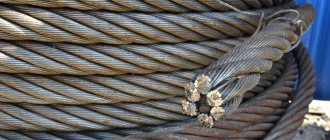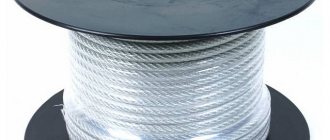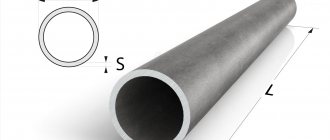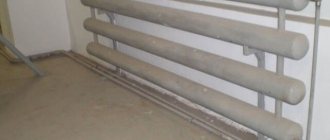Load grippers | 04/19/2017
Rope slings are one of the most common types of load-handling devices. This is explained by their reliability, ease of maintenance, as well as affordable prices from manufacturers of such devices. They combine high performance parameters, are quite flexible, and are recognized as the safest among crane operators and slingers. What is their secret?
Design and GOST
Rope slings have a simple design: it is a steel rope, which has loops at both ends for secure connection with adjacent parts - links or crane hooks. At the end of such loops, steel thimbles are provided - round, triangular or drop-shaped mandrels. The cross section of the thimble has the shape of a groove. At the same time, frictional wear of the ropes is reduced, and the loads acting on the slings are distributed more evenly. The thimbles are made from low-carbon structural steels such as Steel 15 in accordance with GOST 1050, and after stamping they are subjected to carburization.
Structurally, branch and loop rope slings are distinguished. In the first case, the slings include several separate branches, which are interconnected by links made of structural steel and end with a hook. Loop slings are not equipped with hooks, and are designed to secure the lifted load by tying it along the contour. Such links are used for subsequent hanging of a rope sling on the hook of an overhead crane or beam crane.
Technical requirements for the production and operation of rope slings are regulated by GOST 25573 and RD 10-33-93.
The steel rope of the sling is its most critical part, which determines the operational durability and load-carrying capacity of the device. For the manufacture of ropes, drawn wire from high-carbon steels in accordance with GOST 1050 grades from steel 60 and higher is used. Depending on the required load-carrying capacity, the wire diameter is taken within the range of 0.8...2.0 mm. The rope itself is obtained by weaving several wires relative to the core into one or several strands. The lay is predominantly double, cross-shaped. GOST 25573 provides for the use of ordinary wire for these purposes, between the layers of which it is necessary to apply a special rope lubricant. If the rope is made of galvanized wire, then there is no need for such lubrication.
The core of the rope sling is made of durable porous material - hemp, which has the ability to absorb lubricant and at the same time gives the product sufficient elasticity. This makes it possible to easily lay rope slings into coils when not in use. At the same time, the hemp core gives the slings the necessary stability, preventing transverse deformation of the strands from the working tensile load. Much less often, when constant transportation of flammable goods is necessary, asbestos cores are used in rope slings. If the temperature of the transported cargo exceeds 400ºС, then the core is made of steel.
The choice of the standard size of a rope sling is made according to its maximum load-carrying capacity, taking into account that the standard load safety factor, according to RD 10-33-93, cannot be less than 6.
Combination of rope lay directions
Ropes are made with different directions of laying of strands - right and left. With the right direction of lay (designation Z), the strands go from left-up-to-right, with the left direction (designation S): right-up-left. Based on the combination of directions of laying of wires in strands and strands in ropes, one-way and cross-laying ropes are distinguished. In one-way lay ropes, the winding directions of the wires in the outer layer of the strands and the strands in the rope are the same; in cross-lay ropes these directions are opposite.
One-way lay ropes have a smoother surface, their cross-sectional area is better filled, they are more flexible and durable, due to the increased contact surface of the wires with the surface of the block or drum. In cross lay ropes, the outer wires of adjacent strands come into contact at separate points, which increases contact stresses. Due to their tendency to unwind under a tensile load, single-laid ropes are unsuitable for use if a load needs to be suspended freely on one branch. In these cases, non-twisting cross lay ropes are used.
In cases where they want to reduce the torque and wear of the rope due to the linear contact of the wires, they use ropes with a combined lay, in which the same number of strands of right and left lays alternate.
Marking of rope slings
The following versions of rope slings are distinguished:
- Single-branch (marked 1SK).
- Two-branch (marked 2SK).
- Three-branched (marked 3SK).
- Four-branched (marked 4SK).
- Universal straight lines (marked USK-1).
- Universal ring/closed (marked USK-2).
Universal rope slings USK are lightweight devices, and therefore do not have thimbles or other grooves enclosing the rope in their design. Instead, for slings of the USK-2 type, screw clamps or crimp cone bushings, which are made of aluminum, are provided. They should not have sharp edges or edges that could cause the rope to rub against them. The load on all branches should be distributed evenly.
A single-branch rope sling can be with or without a thimble. The limited load-carrying capacity of such devices determines their use primarily in repair work.
Two-branch versions are more functional. Such rope slings consist of:
- Two twisted ropes;
- Clamping bushings;
- Koushey;
- Kryukov;
- Triangular connecting link - open, with a plate or closed.
The choice of standard size is made according to two parameters - the length of the sling and the total diameter of the rope.
The four-branch rope sling 4SK is a pair of shared two-branch devices. Such designs are sometimes called “spider slings”. Here a stronger connecting link is used, made from wire/rod of larger diameter.
A loop rope sling (SKP) is a separate branch of a lifting rope, the ends of which are connected to each other by laying or crimping.
The length of the free end of the rope after its attachment point must be at least 6 of its diameters d. The price of crimped versions is lower, however, in this case, less flexible ropes are used, twisted from wire of increased diameter. Braided slings are used to wrap the cargo being moved; they allow the sling to be more tightly fitted to the desired configuration.
SKP slings with coiling are produced with a load capacity from 0.5 to 16 tons, with a length L from 1 to 8 m. Braided slings of a similar design are manufactured for transporting cargo weighing from 0.5 to 8 tons, in the same length range.
The marking of rope slings includes the designation of the rope and connecting link, as well as the length and load-carrying capacity of the devices in question. All information about the device is placed on a marking tag, without which the operation of rope slings is not permitted.
The rope marking consists of its diameter, the designation of the mechanical characteristics of the material (tensile strength limit in MPa), as well as the laying method. GOST 3077 also provides additional designations that determine the durability of the rope.
Abbreviated marking of rope slings includes the type of device, its length, load capacity, name of the manufacturer, as well as information about the previous testing of the sling (month and year). For example, the designation 4SK-4.0/6000 defines the product as a four-leg rope sling with a maximum load of 4 tons and a length of 6000 mm.
How are textile slings marked?
DESIGN FEATURES
Steel slings are woven from ropes consisting of a core with wire wound around it. The ends of the metal cable are twisted into loops by crimping with an aluminum sleeve or by weaving a sling into the body (hand braiding). This does not apply to ring rope slings, which are a closed loop in which both ends are fastened together. The upper part can be additionally equipped with a thimble, and the lower part - with a hook, lanyard, rigging bracket, and grip. If the sling has several branches, then they are connected at the top on one link, which comes in various shapes.
Each sling must comply with GOST 25573-82 and have a tag indicating the load capacity, test date, sign or name of the manufacturer. These devices are directly related to the safety of the cargo being moved and the lives of people, and therefore must meet all safety requirements. Multi-leg slings must have this tag on each leg.
Slinging schemes
Technological regulations clearly define slinging schemes for specific loads for maximum safety and reliable movement. In cases where the required diagram is not available, cargo transportation is permitted only in the presence of a person responsible for the safe execution of work.
Standard schemes
Content:
Any operation of loading, transporting and orienting cargo in space is carried out using cranes, hoists, winches, etc. And slings are used to firmly grip the load.
Properly selected and secured, slings should perform the following tasks:
1. ensure the safety of loading workers and the integrity of the transported cargo.
2. prevent rocking of fixed goods (building materials, parts of metal structures and parts of reinforced concrete products), and also ensure uniform distribution of the load between the elements.
Incorrectly selected slings can result in both monetary loss due to cargo damage and personal injury. In this article we will look at all types of slings, their advantages, as well as rules for choosing equipment.
Table for calculating the working load factor at inclination angles
It is also important to understand that the safety factor does not mean the ability to lift a load of 7 tons with a one-ton sling. This figure shows the ability of the sling to withstand and not break under dynamic loads during a sharp rise or breakage of one of the branches.
Examination card No. 5
1.Test lift and its purpose
Test lift – a lift designed to determine the reliability of the brake of the crane lifting mechanism. A test lift of the load is carried out as follows: First, it is raised to a height of 100-200 mm to ensure the correctness of the sling, the uniform tension of the slings, the stability of the crane, and the reliability of the brakes. Then, making sure that the brake holds (the load has not dropped), the slings are tensioned evenly, the center of gravity of the load is maintained (there is no skew), give a signal to lift the load to the required height and leave the danger zone in the direction opposite to the direction of movement of the load. If re-slinging is necessary, the load must be lowered to the ground.











